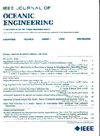使用基于信道的结构,色散率分数,以及水下图像的总体饱和度和色相的盲质量评估
IF 5.3
2区 工程技术
Q1 ENGINEERING, CIVIL
引用次数: 0
摘要
在水下海底环境中,光衰减、水体浑浊以及光学设备的局限性使捕获的图像对比度和质量差、比例退化、可见度低、色彩丰富度低。近年来,各种图像增强技术被用于提高图像质量,这给水下图像的质量评估带来了新的挑战。在本研究中,我们提出了一种创新的、通用的水下图像盲质量评估方法。我们的方法利用基于结构和轮廓的度量,结合色散率分析,在对手色彩空间内量化图像退化和色彩丰富度。具体来说,我们通过使用方向Kirsch核计算边缘幅度来测量比例退化,并通过图像轮廓和显著性图进行增强。为了评估色彩质量,使用色散率和总体饱和度和色调来捕捉增强方法引入的色彩失真。最终的质量分数是通过在广泛的数据集上训练的多元线性回归模型获得的。在三个基准数据集上的实验表明,该方法对原始和增强的水下图像都具有较高的精度、一致性和计算效率。本文章由计算机程序翻译,如有差异,请以英文原文为准。
Blind Quality Assessment Using Channel-Based Structural, Dispersion Rate Scores, and Overall Saturation and Hue for Underwater Images
In underwater subsea environments light attenuation, water turbidity, and limitations of the optical devices make the captured images suffer from poor contrast and quality, proportional degradation, low visibility, and low color richness. In recent years, various image enhancement techniques have been applied to improve the image quality, resulting in a new challenge, i.e., the quality assessment of the underwater images. In this study, we introduce an innovative and versatile blind quality assessment method for underwater images without using any references. Our approach leverages structural and contour-based metrics, combined with dispersion rate analysis, to quantify image degradation and color richness within an opponent color space. Specifically, we measure the proportional degradation by computing the edge magnitude using the directional Kirsch kernels, strengthened by image contour and saliency maps. To assess the color quality, chrominance dispersion rates and the overall saturation and hue are used to capture color distortions introduced by enhancement methods. The final quality score is obtained via a multiple linear regression model trained on extensive data sets. Experiments on three benchmark data sets have demonstrated the superior accuracy, consistency, and computational efficiency of the proposed method for both raw and enhanced underwater images.
求助全文
通过发布文献求助,成功后即可免费获取论文全文。
去求助
来源期刊

IEEE Journal of Oceanic Engineering
工程技术-工程:大洋
CiteScore
9.60
自引率
12.20%
发文量
86
审稿时长
12 months
期刊介绍:
The IEEE Journal of Oceanic Engineering (ISSN 0364-9059) is the online-only quarterly publication of the IEEE Oceanic Engineering Society (IEEE OES). The scope of the Journal is the field of interest of the IEEE OES, which encompasses all aspects of science, engineering, and technology that address research, development, and operations pertaining to all bodies of water. This includes the creation of new capabilities and technologies from concept design through prototypes, testing, and operational systems to sense, explore, understand, develop, use, and responsibly manage natural resources.
 求助内容:
求助内容: 应助结果提醒方式:
应助结果提醒方式:


